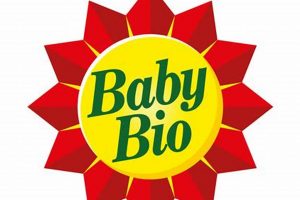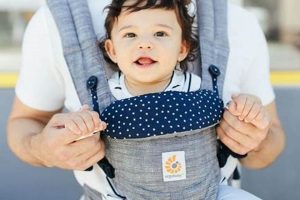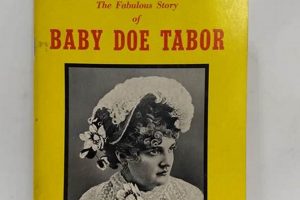The selection of optimal infant soothers involves navigating a diverse market of products designed to meet the varied needs of babies and their caregivers. These items, typically constructed from silicone or latex, are intended to satisfy a baby’s natural sucking reflex, potentially offering comfort and aiding in self-soothing. Considerations include material safety, nipple shape, size appropriateness for the infant’s age, and overall design features that promote proper oral development.
Appropriate use of these infant soothers can provide several benefits. They may assist in calming a fussy baby, particularly during times of stress or transition. Some research suggests a potential link between their use and a reduced risk of Sudden Infant Death Syndrome (SIDS), although further investigation is ongoing. Historically, parents have sought methods to comfort infants, with early versions crafted from various materials. Modern iterations prioritize safety standards and ergonomic designs developed through research and technological advancements.
The following sections will delve into specific aspects to consider when choosing appropriate infant soothers. These include different nipple designs and their impact on oral development, materials commonly used in manufacturing and their safety profiles, cleaning and sterilization protocols, and advice on weaning infants from pacifier use.
Guidance for Selecting Optimal Infant Soothers
The appropriate selection of an infant soother requires careful consideration of several key factors to ensure safety and efficacy.
Tip 1: Prioritize Material Safety: Opt for products constructed from BPA-free, phthalate-free, and latex-free materials to minimize the risk of allergic reactions or exposure to harmful chemicals. Silicone is often considered a hypoallergenic and durable choice.
Tip 2: Select an Age-Appropriate Size: Pacifiers are typically available in various sizes designed for different age ranges. Choosing the correct size ensures proper fit and reduces the risk of choking hazards or hindering oral development.
Tip 3: Consider Nipple Shape and Design: Different nipple shapes, such as orthodontic, round, or flat, can influence oral development. Consult with a pediatrician or dentist to determine the most suitable shape for the infant’s needs.
Tip 4: Inspect for One-Piece Construction: Pacifiers with a one-piece design minimize the risk of parts detaching and becoming choking hazards. Ensure the product is sturdy and durable to withstand repeated use.
Tip 5: Maintain Rigorous Hygiene: Sterilize new pacifiers before first use and regularly clean them with soap and water or a dishwasher. Replace pacifiers every few weeks or at the first sign of damage.
Tip 6: Observe Infant’s Response: Monitor the infant’s reaction to the chosen pacifier. If the infant consistently rejects the pacifier or exhibits signs of discomfort, consider trying a different type or shape.
Tip 7: Limit Prolonged Use: While pacifiers can be beneficial for soothing, prolonged use, particularly beyond the age of two, may contribute to dental problems. Establish a plan for gradual weaning as the child grows.
Careful adherence to these guidelines facilitates informed selection and promotes the safe and effective utilization of infant soothers, contributing to the child’s comfort and well-being.
The subsequent sections will expand upon these points, offering additional information for making informed decisions regarding infant care products.
1. Material Safety
Material safety is a foundational requirement in the selection of effective infant soothers. The composition of these items directly impacts an infant’s health and well-being, as prolonged contact with the mouth can facilitate the absorption of potentially harmful substances. The use of materials containing Bisphenol A (BPA), phthalates, or latex, for example, presents risks of endocrine disruption, allergic reactions, and exposure to carcinogenic compounds, respectively. The absence of these substances is therefore a critical determinant of product quality and safety. The market offers pacifiers manufactured from medical-grade silicone, which is generally considered hypoallergenic, durable, and resistant to bacterial growth, representing a safer alternative. A substandard pacifier, constructed from unidentified or potentially hazardous materials, increases the likelihood of adverse health effects, ranging from skin irritation to more severe systemic issues.
The implementation of stringent manufacturing standards and rigorous testing protocols are necessary to ensure material integrity. Regulatory bodies, such as the Consumer Product Safety Commission (CPSC) in the United States, establish guidelines and conduct testing to verify compliance with safety standards. Responsible manufacturers voluntarily submit their products for independent testing to demonstrate adherence to these requirements and to provide consumers with verifiable assurance of product safety. These certifications, often displayed on product packaging, serve as important indicators of a manufacturer’s commitment to material safety and product quality. Conversely, the absence of such certifications should prompt caution, as it may signal inadequate testing or non-compliance with established safety standards.
In summary, the link between material safety and the overall quality of infant soothers is undeniable. Prioritizing products constructed from well-documented, non-toxic materials is essential for minimizing health risks and ensuring the infant’s safety. While third-party certifications offer valuable reassurance, continuous vigilance and informed decision-making remain paramount in the selection process. The challenges lie in navigating marketing claims and verifying the accuracy of material specifications, underscoring the need for thorough research and informed consumerism within the context of infant care product selection.
2. Nipple Shape
The nipple shape of an infant soother significantly influences its suitability and, consequently, its designation as among the “best pacifiers for babies.” The form directly impacts the infant’s oral development, sucking patterns, and overall comfort. A poorly designed nipple can contribute to dental malocclusion, difficulties in latching during breastfeeding, or even gagging and discomfort. Therefore, a well-designed nipple, mimicking the natural shape of a mother’s nipple during breastfeeding, is generally preferred. For example, orthodontic pacifiers are designed to minimize pressure on the developing palate and teeth, promoting proper alignment and reducing the risk of future dental issues. The selection of an inappropriate nipple shape can lead to the rejection of the pacifier by the infant, negating its intended soothing effect and potentially causing frustration for both the infant and caregiver. Therefore, the design’s influence makes it an indispensable part of “best pacifiers for babies.”
Several nipple shapes exist, each purported to offer specific benefits. Round nipples, often resembling traditional bottle nipples, are commonly available. However, orthodontic nipples, featuring a flattened shape on one side, are increasingly recommended by pediatric dentists. The flattened side rests against the tongue, reducing pressure on the palate and allowing for more natural tongue movement during sucking. Other variations include symmetrical nipples, designed to be equally comfortable regardless of orientation in the infant’s mouth. Real-world application involves observing the infant’s sucking patterns and oral anatomy to determine the most appropriate shape. Some infants may exhibit a preference for a particular shape, while others may require an orthodontic nipple due to a pre-existing oral condition. The practical significance of understanding nipple shape lies in the ability to proactively address potential oral developmental issues and promote comfortable and effective pacifier use.
In summary, the nipple shape is a crucial attribute that determines the overall quality and effectiveness of an infant soother. An informed selection, considering both the infant’s individual needs and the documented benefits of various shapes, is paramount. Challenges include the abundance of marketing claims and the potential for misinformation. Overcoming these hurdles requires consulting with pediatricians or dentists, carefully assessing product specifications, and observing the infant’s response to different designs. Ultimately, prioritizing optimal nipple shape is integral to promoting healthy oral development and ensuring the infant’s comfort, solidifying its role as a deciding factor of “best pacifiers for babies.”
3. Age Appropriateness
Age appropriateness is a critical determinant of the suitability and effectiveness of infant soothers, directly influencing their classification among “best pacifiers for babies.” A soother designed for a newborn presents different characteristics than one intended for an older infant, primarily concerning size and material resilience. An inappropriately sized pacifier can pose significant risks, including choking hazards if too small, or hindering proper oral development if too large. Furthermore, the resilience of the material must align with the infant’s developmental stage, as older infants may possess stronger sucking reflexes capable of damaging or dislodging parts of a pacifier designed for younger, less developed oral musculature. Therefore, the selection of an age-appropriate soother is not merely a matter of preference, but a fundamental safety and developmental consideration.
Manufacturers typically provide age guidelines on product packaging, indicating the intended age range for a given pacifier. These guidelines are based on average developmental milestones and should be considered as a starting point. However, individual infants may exhibit variations in oral motor skills and size, necessitating careful observation and adjustment. For instance, a smaller-than-average infant may require a smaller pacifier even within the recommended age range, while a larger infant may transition to a larger size sooner. The practical application of age appropriateness involves regularly assessing the fit and condition of the pacifier, monitoring for signs of wear or damage, and adjusting the size as the infant grows. Furthermore, it entails understanding the infant’s sucking patterns and oral reflexes to determine if the selected pacifier is adequately supporting healthy oral development.
In summary, age appropriateness is an indispensable attribute of high-quality infant soothers. Challenges to proper implementation include reliance solely on manufacturer guidelines without individual assessment, and a failure to regularly inspect and replace worn or damaged pacifiers. Overcoming these challenges requires a proactive and informed approach, prioritizing the infant’s unique developmental needs and adhering to established safety recommendations. This informed selection is a critical component in considering “best pacifiers for babies,” thus ensuring safety and appropriate oral development.
4. One-Piece Design
The one-piece design in infant soothers represents a critical safety feature that significantly contributes to the designation of a product as among the “best pacifiers for babies”. This design minimizes the risk of component separation, thereby reducing the potential for choking hazards and related adverse events.
- Reduced Choking Hazard
The primary advantage of a one-piece construction lies in its elimination of detachable parts. Traditional pacifiers with multiple components, such as a nipple attached to a shield, present a risk if the bond weakens and a piece becomes dislodged. Infants can then aspirate the detached component, leading to airway obstruction. A one-piece design mitigates this risk by ensuring structural integrity and preventing separation, a crucial factor in infant safety.
- Enhanced Hygiene
One-piece construction often simplifies cleaning and sterilization protocols. Multiple-piece pacifiers can harbor bacteria and mold within the seams and crevices where components join. The seamless design of a one-piece pacifier reduces these potential breeding grounds, facilitating more thorough cleaning and minimizing the risk of microbial contamination. This is particularly important for infants with developing immune systems.
- Durability and Longevity
The absence of connection points in a one-piece design enhances the overall durability and lifespan of the pacifier. Multiple-piece pacifiers are prone to weakening at the joints due to repeated use, sterilization, and exposure to saliva. The seamless construction of a one-piece unit provides increased resistance to wear and tear, extending the useful life of the product and reducing the frequency of replacements.
- Material Considerations
While the one-piece design is beneficial, the material used remains crucial. Medical-grade silicone is frequently employed in one-piece pacifiers due to its hypoallergenic properties, durability, and resistance to degradation. A robust material, coupled with the seamless construction, ensures a safe and reliable product for infant use. Conversely, even a one-piece design can be compromised if constructed from substandard or easily degraded materials.
The advantages of a one-piece design, encompassing enhanced safety, improved hygiene, and increased durability, solidify its importance in the context of infant soothers. While not the sole determinant of quality, this design feature plays a significant role in classifying a pacifier as among the “best pacifiers for babies”, prioritizing the safety and well-being of the infant.
5. Ease of Cleaning
The characteristic of easy cleaning is intrinsically linked to the concept of superior infant soothers. A direct correlation exists between the complexity of a pacifier’s design and the potential for microbial accumulation. Pacifiers with intricate designs, multiple crevices, or detachable components present increased surface area and hidden spaces where bacteria, mold, and other contaminants can thrive. The inability to effectively clean these areas poses a direct threat to the infant’s health, increasing the risk of oral thrush, gastrointestinal infections, and other related ailments. Therefore, straightforward cleaning protocols are essential attributes of soothers intended for infant use.
Soothers with minimal surface complexity, smooth contours, and dishwater-safe materials offer distinct advantages regarding hygiene maintenance. For instance, a single-piece silicone pacifier with a simple, unadorned design can be easily sanitized via boiling, steaming, or dishwasher cycles, ensuring thorough decontamination. Conversely, a multi-piece pacifier with fabric components or intricate embellishments may require more laborious hand-washing, increasing the likelihood of residual contamination. Real-world examples illustrate the impact of cleaning ease; parents who utilize easily cleaned pacifiers report fewer instances of infant illness, while those struggling with cleaning complex designs frequently encounter hygiene-related problems. The practical significance of understanding this link lies in the potential to significantly reduce the risk of infant morbidity through simple, informed product selection.
In summary, the ease of cleaning is not merely a convenience but a critical safety factor in selecting an infant soother. Products designed for simplified cleaning promote optimal hygiene and minimize the risk of microbial contamination. The challenges lie in identifying genuinely easy-to-clean designs amid marketing claims and diverse product offerings. However, by prioritizing minimalist designs, dishwater-safe materials, and single-piece construction, caregivers can confidently select soothers that facilitate thorough cleaning and contribute to the infant’s overall health and well-being. As such, ease of cleaning should rank among the top priorities when choosing among the best pacifiers for babies.
6. Durability
The longevity and resistance to degradation inherent in a soother’s construction are central to its classification as among the “best pacifiers for babies.” Premature failure of these items presents both economic and safety concerns. Frequent replacements necessitate increased expenditure, while compromised structural integrity raises the risk of component separation and subsequent choking hazards. Therefore, a durable soother provides sustained value and mitigates potential harm. A substandard product, susceptible to cracking, tearing, or discoloration, undermines its intended function and compromises infant safety. A correlation exists between material quality, manufacturing processes, and the overall lifespan of these products.
The composition materials used in pacifier production, such as medical-grade silicone or natural rubber latex, directly affect their durability. Silicone, known for its resilience and resistance to temperature fluctuations, often demonstrates a longer lifespan compared to latex, which can degrade more readily with repeated sterilization or exposure to saliva. The manufacturing process, involving molding and assembly techniques, impacts structural integrity. A well-constructed soother, free from seams or weak points, exhibits greater resistance to cracking or separation under normal use. Real-world applications involve observing wear and tear during routine cleaning and inspection. A pacifier exhibiting signs of degradation, such as surface imperfections or material softening, should be promptly replaced to prevent potential hazards.
In summary, durability is a non-negotiable attribute of high-quality infant soothers. The selection of a durable product minimizes replacement frequency, reduces the risk of safety hazards, and ensures sustained value for caregivers. Challenges arise from the difficulty in assessing long-term durability at the point of purchase. Overcoming these challenges requires careful consideration of material specifications, manufacturer reputation, and adherence to recommended cleaning and replacement schedules. By prioritizing durability, caregivers contribute to the safety and well-being of the infant, solidifying the link between durability and the classification of “best pacifiers for babies.”
7. Acceptance
Infant acceptance is paramount in determining the suitability of a pacifier. No matter the safety features, design innovations, or material qualities, a pacifier’s utility is negated if the infant consistently rejects it. Acceptance encompasses both the infant’s willingness to take the pacifier initially and to maintain its use for soothing purposes. Varied factors influence this acceptance, including nipple shape, texture, size, and the individual infant’s preferences. Consequently, identifying a pacifier readily accepted by the infant is a crucial step in selecting from available options. A pacifier rejected causes parental frustration and does not fulfil its intended soothing function, thus any measure of ‘best pacifier’ must include the propensity for acceptance.
Factors affecting infant acceptance include prior feeding experiences. For breastfed infants, nipple shapes closely resembling the maternal nipple may promote greater acceptance, minimizing nipple confusion and supporting continued breastfeeding. Texture also plays a role; some infants prefer softer silicone nipples, while others may respond better to firmer materials. Real-world scenarios demonstrate that infants display strong preferences, often accepting one brand or nipple shape while rejecting others with similar specifications. Practical application involves systematically testing different pacifier types to identify the one most readily accepted by the individual infant. This may require purchasing multiple brands and styles to determine the infant’s preference through trial and error.
While objective criteria like material safety and design contribute to assessing pacifier quality, infant acceptance represents a subjective but equally crucial factor. Challenges include the unpredictable nature of infant preferences and the potential for these preferences to change over time. Overcoming these challenges requires patience, observation, and a willingness to adapt to the infant’s evolving needs. Ultimately, a soother’s value is limited without infant acceptance, highlighting the necessity of considering this factor when categorizing “best pacifiers for babies,” and making it a key component in the quest for infant comfort and soothing.
Frequently Asked Questions
The following section addresses common inquiries regarding the selection and utilization of infant soothers. These responses are intended to provide factual and objective information to aid caregivers in making informed decisions.
Question 1: At what age is it appropriate to introduce a pacifier?
The introduction of a pacifier is generally recommended after breastfeeding is well-established, typically around 3-4 weeks of age. Introducing it too early may interfere with the infant’s latch and breastfeeding success. For bottle-fed infants, a pacifier can be introduced earlier, as feeding patterns are already established.
Question 2: How frequently should pacifiers be replaced?
Pacifiers should be replaced every 2-3 months, or sooner if signs of wear and tear are apparent. Cracks, tears, discoloration, or changes in texture indicate the need for immediate replacement. Regular inspection is crucial to ensure infant safety.
Question 3: What are the potential benefits of pacifier use?
Pacifier use can provide several benefits, including soothing fussy infants, aiding in sleep initiation, and potentially reducing the risk of Sudden Infant Death Syndrome (SIDS), particularly during sleep. However, these benefits must be weighed against potential risks.
Question 4: What are the potential drawbacks of pacifier use?
Potential drawbacks include nipple confusion in breastfed infants, increased risk of ear infections, and potential dental problems with prolonged use. Careful monitoring and appropriate weaning strategies are essential to mitigate these risks.
Question 5: How should pacifiers be properly cleaned and sterilized?
New pacifiers should be sterilized before initial use. Subsequent cleaning can be achieved with warm soapy water or by placing them in a dishwasher (top rack). Regular sterilization is recommended, particularly for infants under six months of age or those with compromised immune systems. Strict adherence to product-specific cleaning instructions is advised.
Question 6: What strategies can be employed for pacifier weaning?
Pacifier weaning should be a gradual process, typically initiated between 6 months and 2 years of age. Strategies include limiting pacifier use to naptime and bedtime, gradually reducing the duration of use, and offering alternative comfort objects. Consistency and patience are crucial for successful weaning.
In summary, the responsible and informed use of infant soothers requires careful consideration of both potential benefits and risks. Adherence to established safety guidelines and regular monitoring of the infant’s oral development are essential for ensuring a positive outcome.
The subsequent section will delve into specific pacifier brands and models commonly available on the market.
Selecting Optimal Infant Soothers
The preceding sections have explored critical aspects of infant soothers, ranging from material safety and nipple shape to age appropriateness, design, ease of cleaning, durability, and infant acceptance. Each factor contributes significantly to the overall suitability and safety of these products. The ideal selection process necessitates a holistic approach, considering individual infant needs alongside established safety guidelines and expert recommendations. The term “best pacifiers for babies” encompasses a product selection that is aligned with these safety-focused attributes.
The responsible use of infant soothers requires ongoing vigilance and informed decision-making. Caregivers are encouraged to remain abreast of evolving safety standards and to consult with pediatricians or dentists regarding any concerns related to infant oral development. The long-term well-being of the infant is the paramount consideration, and careful attention to the attributes discussed herein will contribute to achieving that goal. The choices made during infancy have the potential to affect well being for many years.







